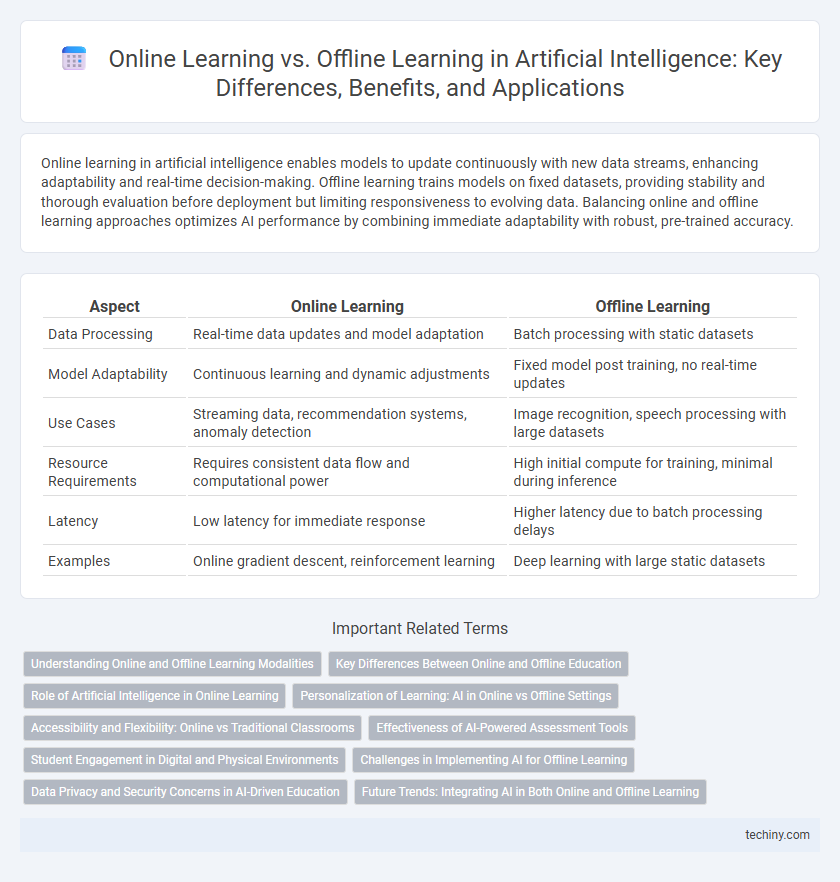Online learning in artificial intelligence enables models to update continuously with new data streams, enhancing adaptability and real-time decision-making. Offline learning trains models on fixed datasets, providing stability and thorough evaluation before deployment but limiting responsiveness to evolving data. Balancing online and offline learning approaches optimizes AI performance by combining immediate adaptability with robust, pre-trained accuracy.
Table of Comparison
| Aspect | Online Learning | Offline Learning |
|---|---|---|
| Data Processing | Real-time data updates and model adaptation | Batch processing with static datasets |
| Model Adaptability | Continuous learning and dynamic adjustments | Fixed model post training, no real-time updates |
| Use Cases | Streaming data, recommendation systems, anomaly detection | Image recognition, speech processing with large datasets |
| Resource Requirements | Requires consistent data flow and computational power | High initial compute for training, minimal during inference |
| Latency | Low latency for immediate response | Higher latency due to batch processing delays |
| Examples | Online gradient descent, reinforcement learning | Deep learning with large static datasets |
Understanding Online and Offline Learning Modalities
Online learning in Artificial Intelligence leverages digital platforms to provide flexible access to algorithms, enabling models to update continuously with streaming data. Offline learning, or batch learning, involves training AI models on a fixed dataset before deployment, ensuring stability but limiting adaptability to new information. Understanding these modalities is crucial for selecting appropriate AI training strategies based on real-time data availability and application requirements.
Key Differences Between Online and Offline Education
Online learning leverages AI-driven platforms to provide personalized, adaptive content accessible anytime, enhancing flexibility and scalability for diverse learners. Offline learning relies on traditional classroom settings where real-time interactions and hands-on experiences foster immediate feedback and collaborative skills development. Key differences include accessibility, with online education overcoming geographic barriers, while offline education emphasizes direct social engagement and structured schedules.
Role of Artificial Intelligence in Online Learning
Artificial Intelligence enhances online learning by personalizing educational content through adaptive algorithms that analyze student performance in real-time. AI-driven platforms employ natural language processing and predictive analytics to offer tailored feedback and identify knowledge gaps, significantly improving learner engagement and outcomes. The integration of AI tools in online education facilitates scalable, data-informed instruction that surpasses traditional offline learning constraints.
Personalization of Learning: AI in Online vs Offline Settings
AI-driven online learning platforms utilize real-time data analytics and adaptive algorithms to personalize educational content, addressing individual learner preferences and pacing. In contrast, offline learning relies on limited face-to-face interactions and traditional assessment methods, offering less precise customization of learning experiences. The integration of AI enhances personalization by continuously evaluating student performance and adjusting instruction dynamically in online environments.
Accessibility and Flexibility: Online vs Traditional Classrooms
Online learning in artificial intelligence offers unparalleled accessibility, enabling students worldwide to access high-quality AI courses without geographical constraints. Flexible scheduling in online platforms allows learners to study at their own pace, accommodating diverse time zones and personal commitments. Traditional classrooms, while providing direct interaction, often lack the convenience and adaptability that online AI education delivers for widespread skill development.
Effectiveness of AI-Powered Assessment Tools
AI-powered assessment tools significantly enhance the effectiveness of online learning by providing real-time feedback and personalized evaluations, which adapt to individual learner needs and pace. These tools leverage machine learning algorithms to analyze diverse data points, enabling precise measurement of comprehension and skill acquisition compared to traditional offline assessments. Consequently, AI-driven assessments facilitate targeted interventions and continuous improvement, optimizing educational outcomes in digital environments.
Student Engagement in Digital and Physical Environments
Student engagement in digital environments relies heavily on interactive tools such as AI-driven quizzes, gamified content, and real-time feedback systems, which personalize the learning experience and maintain attention. Offline learning environments foster engagement through direct social interaction, hands-on activities, and immediate instructor support, enhancing motivation and collaboration. Combining AI technologies in online platforms with experiential offline methods can optimize student engagement by catering to diverse learning preferences and promoting active participation.
Challenges in Implementing AI for Offline Learning
Challenges in implementing AI for offline learning include limited access to real-time data and updates, which hinders the adaptability of AI models trained without continuous feedback. Offline learning requires robust algorithms capable of generalizing from static datasets, often leading to decreased accuracy when encountering new or unseen scenarios. Moreover, the computational resource demands and latency in updating AI models without online connectivity pose significant obstacles to effective deployment in offline environments.
Data Privacy and Security Concerns in AI-Driven Education
Online learning platforms leverage AI algorithms to personalize education but face significant data privacy and security challenges due to continuous data collection and cloud storage vulnerabilities. Offline learning environments offer enhanced data protection by processing information locally on devices, reducing exposure to cybersecurity threats and unauthorized data access. Balancing the benefits of AI-driven personalization with robust encryption protocols and strict data governance is critical to safeguarding student information in digital education systems.
Future Trends: Integrating AI in Both Online and Offline Learning
Integrating AI in both online and offline learning is revolutionizing education by delivering personalized, adaptive experiences that optimize student engagement and outcomes. Future trends highlight the seamless fusion of AI-powered analytics, real-time feedback, and immersive technologies such as augmented reality to enhance classroom instruction and virtual learning environments. Enhanced AI integration will drive data-informed teaching strategies, bridging gaps between digital and traditional methods for a more cohesive educational ecosystem.
Online Learning vs Offline Learning Infographic

 techiny.com
techiny.com